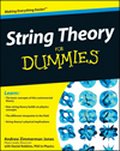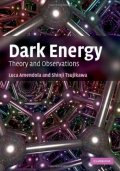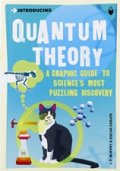 It was inevitable that the “Dummies” series of books would get around to String Theory for Dummies. Intriguingly, it’s written by the physics guide at About.com, Andrew Zimmerman Jones (with Daniel Robbins). The Dummies guide explains the basic concepts of what the cover refers to as the controversial theory, how it builds on known principles, its physical implications and how there are several different viewpoints on string theory.
It was inevitable that the “Dummies” series of books would get around to String Theory for Dummies. Intriguingly, it’s written by the physics guide at About.com, Andrew Zimmerman Jones (with Daniel Robbins). The Dummies guide explains the basic concepts of what the cover refers to as the controversial theory, how it builds on known principles, its physical implications and how there are several different viewpoints on string theory.
In case you didn’t know string theory hopes to be a theory of everything and hinges on the notion that particles and energy are fundamentally string-like vibrations and membranes (referred to chirpily in the jargon of the theory as branes) in a multidimensional spacetime most of whose dimensions we cannot observe because they are wrapped up small and tight. It’s just possible that if string theory ever finds itself in a position of being able to predict anything observable (in the way that quantum theory and relativity theory most certainly do), then we might be on to something. We might even be able to explain dark matter and the subject of our next book dark energy.
 Physicist Luca Amendol and cosmologist Shinki Tsujikawa writing in Dark Energy – Theory and Observations, attempt to explain the basics of this mysterious “force” that pervades the universe and is causing an apparent acceleration of the expansion of the universe that the conventional Big Bang model cannot sustain. It’s as if there’s something acting against the force of gravity that would sensibly be otherwise slowing the expansion.
Physicist Luca Amendol and cosmologist Shinki Tsujikawa writing in Dark Energy – Theory and Observations, attempt to explain the basics of this mysterious “force” that pervades the universe and is causing an apparent acceleration of the expansion of the universe that the conventional Big Bang model cannot sustain. It’s as if there’s something acting against the force of gravity that would sensibly be otherwise slowing the expansion.
If you fancy delving into the cosmological constant, quintessence, k-essence, perfect fluid models and modified gravity, than Amendol and Tsujikawa have it all. It’s heavy on the references and heavy on the mathematical formulae, it’s no Dummies’ guide, in other words. But, considering it discusses, as does String Theory for Dummies, a concept that may or may not exist at all, it does not make for light reading.
In total contrast, Stuart Clark’s The Big Questions – The Universe is more squarely aimed at the non-specialist reader. Clark confronts the usual big questions of science and philosophy but gives his answers a refreshingly sharp edge: What is the universe? How old is the universe? What is a black hole? And, inevitably what is dark energy? Clark also discusses the possibility of extraterrestrial life, the origin of life on earth, and whether or not there are so-called parallel or alternative universes.
 I’ve never been a fan of graphic novels, but JP MvEvoy and Oscar Zarate offer a valiant effort in bringing the form to non-fiction and specifically quantum theory in Introducing Quantum Theory – a graphic guide. Apparently, although quantum theory is notoriously difficult to grasp, it is explained in this book with patience, wit and clarity. To my eye though, I cannot see how it is made any clearer by cartoons of Schrodinger and Einstein regardless of how well drawn they are. That said, it is possible that teenage comic fans attempting to get to grips with the far reaches of the physics curriculum may find some inspiration.
I’ve never been a fan of graphic novels, but JP MvEvoy and Oscar Zarate offer a valiant effort in bringing the form to non-fiction and specifically quantum theory in Introducing Quantum Theory – a graphic guide. Apparently, although quantum theory is notoriously difficult to grasp, it is explained in this book with patience, wit and clarity. To my eye though, I cannot see how it is made any clearer by cartoons of Schrodinger and Einstein regardless of how well drawn they are. That said, it is possible that teenage comic fans attempting to get to grips with the far reaches of the physics curriculum may find some inspiration.
Finally, Michael Byers’ novel Percival’s Planet is a novel of ambition and obsessions centred on the race to discover (the planet) Pluto in 1930. The trouble with a novel as opposed to a history is discerning, which bits are fact and which bits are fiction. An issue that worried critics of Michael Crichton and Dan Brown alike.